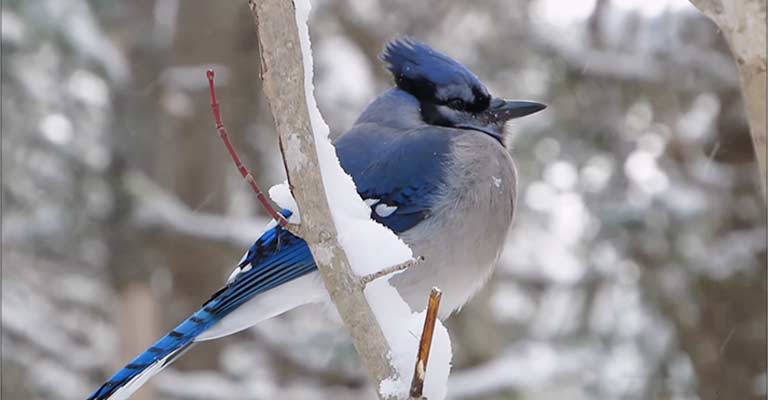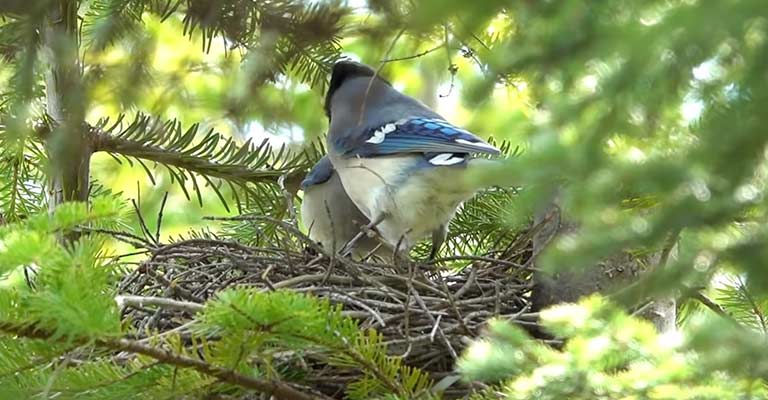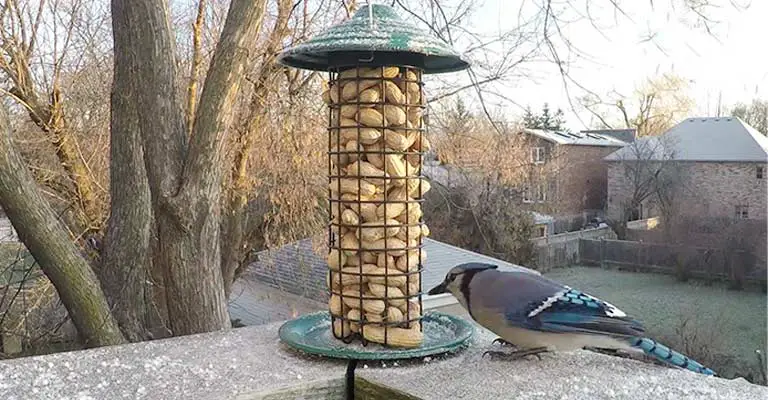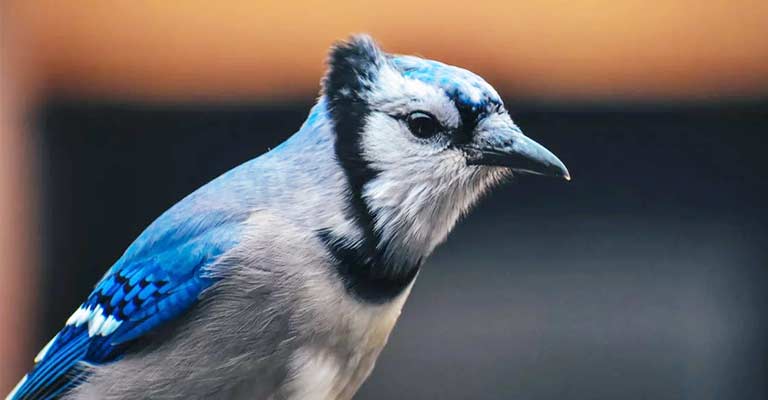As winter blankets the landscape in serene stillness, one can’t help but wonder how the vibrant and energetic Blue Jay, with its striking azure plumage, manages to endure the harsh challenges of the cold season.
In this exploration, we embark on a journey into the resilient world of Blue Jays, uncovering how Blue Jays survive winter using some remarkable strategies to brave the biting cold and scarcity of resources.
Join us as we delve into the fascinating behaviors, unique characteristics, and survival instincts that make Blue Jays true winter warriors, shedding light on the intricate ways in which nature equips them to face the frigid months ahead.
Get ready to be captivated by the story of how these charismatic birds navigate and conquer the challenges of winter, painting a vivid picture of nature’s resilience in the face of adversity.

How Blue Jays Survive Winter?
Winter, with its icy grip and snow-covered landscapes, poses formidable challenges to wildlife. Amidst this frozen realm, Blue Jays, with their striking blue feathers and vibrant personalities, stand out as resilient survivors.
Foraging Tactics: Mastering the Art of Winter Feasts
Blue Jays are resourceful foragers, and this skill becomes particularly vital during winter when food becomes scarce. Known for their omnivorous diet, Blue Jays adeptly switch between seeds, nuts, insects, and even small vertebrates.
Their strong bills are perfectly suited for cracking open nuts, providing them with a valuable energy source during the lean winter months.
One notable adaptation is the Blue Jay’s ability to cache food. These intelligent birds stash away surplus food in various locations, creating a winter pantry.
Studies suggest that they possess an impressive spatial memory, allowing them to retrieve these hidden treasures when food is scarce. This strategic caching behavior not only helps them survive but also showcases their remarkable cognitive abilities.
Thermal Regulation: Fluffing Feathers and Sunbathing
Surviving winter requires efficient thermal regulation, and Blue Jays have evolved ingenious ways to stay warm. One notable behavior is feather fluffing.
By trapping a layer of air within their feathers, Blue Jays create an insulating barrier against the cold. This fluffing action helps them conserve body heat, ensuring they remain snug even in freezing temperatures.
Additionally, Blue Jays engage in sunbathing a surprising behavior for winter. When the sun graces the winter sky, these birds take advantage of its warmth.
They spread their wings and exposed their plumage to the sunlight, absorbing the much-needed heat. This sunbathing ritual not only aids in thermoregulation but also serves as a fascinating winter spectacle.
Communal Roosting: Strength in Numbers
Winter nights can be bitterly cold, and Blue Jays, like many bird species, have devised a communal strategy to combat the chill.
They engage in communal roosting, where groups of individuals gather in a single location to share body heat. The collective warmth generated by the group provides insulation against the cold, enhancing their chances of survival.
Communal roosting isn’t just about warmth; it also serves as a social activity, reinforcing social bonds within the group.
These winter gatherings highlight the cooperative nature of Blue Jays, showcasing their ability to adapt not only physically but also socially to the challenges of winter.
Cozy Nests: Sheltering Against the Elements

Blue Jays invest considerable effort in building well-insulated nests, a crucial aspect of their winter survival strategy. The nests, constructed high in the trees, provide a secure haven against the biting winds and snow.
Blue Jays often utilize evergreen foliage, creating a dense and well-insulated structure that shields them from the elements.
The choice of nesting materials is critical. Blue Jays incorporate a variety of materials, including twigs, leaves, and feathers, to enhance insulation. The result is a snug retreat that not only serves as a shelter during winter but also as a safe space for raising their young when spring arrives.
Migration Myth: Debunking Winter Disappearance
Unlike some bird species that migrate south during winter, Blue Jays are generally considered non-migratory.
While individual Blue Jays may shift their locations based on food availability, the species, as a whole, does not undertake long-distance migrations. This decision to tough out the winter in their home territories further emphasizes their adaptation to colder climates.
The misconception of Blue Jays completely disappearing during winter might arise from their altered behavior and less conspicuous presence.
Their muted colors and quieter calls during winter contribute to the illusion of a diminished population. However, keen observers can still witness these resilient birds navigating the winter landscape with their characteristic determination.
Adaptability in Urban Environments: Navigating Human-Modified Landscapes
Blue Jays showcase remarkable adaptability, not just to natural environments but also to human-modified landscapes. Urban areas with bird feeders and parks become vital resources during winter.
Blue Jays readily exploit these artificial food sources, showcasing their ability to coexist with human activities. Their adaptability to urban environments raises questions about the role humans play in shaping the winter survival strategies of wildlife.
By providing supplemental food through bird feeders, humans unintentionally become a part of the intricate web of interactions that define the winter survival of Blue Jays.
What Do Blue Jays Eat in the Wintertime and How?

Blue Jays undergo dietary adaptations during the winter months to navigate the challenges posed by colder weather.
Seeds: A Winter Staple
As the availability of insects diminishes in winter, Blue Jays turn to seeds as a reliable food source. Their specialized beaks allow them to crack open hard shells, with acorns being a preferred choice. Foraging on the ground and utilizing bird feeders for sunflower seeds and peanuts supplement their seed intake.
Foraging Behavior and Food Caching
Blue Jays showcase opportunistic foraging behavior by hiding seeds and nuts in various locations, creating a food stash for lean times. This caching strategy becomes crucial during harsh weather conditions or when natural food sources are scarce.
Fruits: Nature’s Winter Bounty
While fresh fruit may be scarce, Blue Jays incorporate berries from plants like holly and juniper trees into their winter diet. These fruits contribute to their nutritional intake and help maintain energy levels.
Insects: Finding Protein in Winter
Insects, a significant part of a Blue Jay’s warmer-month diet, become less abundant in winter. However, these resourceful birds still manage to find insect larvae, spiders, and small invertebrates hiding in bark crevices or under tree bark.
Carnivorous Aspects: Vertebrates on the Menu
Blue Jays are known to consume small vertebrates like frogs, lizards, and nestling birds, although this portion of their diet is less prominent in winter. This carnivorous behavior highlights their adaptability and versatility in meeting nutritional needs.
Beak Adaptations and Nutrient Extraction

Possessing strong, sturdy beaks, Blue Jays can efficiently handle a range of food items. Their omnivorous nature and the ability to extract nutrients from different sources contribute to their resilience in the face of changing seasons.
The winter diet of Blue Jays reflects their flexible and adaptable approach. From seeds and fruits to insects and small vertebrates, their opportunistic foraging behavior, food caching strategy, and dietary adjustments showcase the resourcefulness of Blue Jays in coping with the challenges of winter, contributing to their overall success and survival in diverse environments.
Foraging Techniques in Winter
Blue Jays employ various strategies to collect food during the winter months, ensuring their nutritional needs are met despite the challenges posed by colder weather.
Ground Foraging
Blue Jays are often observed foraging on the ground, utilizing their keen eyesight to spot seeds and fallen fruits. This behavior is particularly prominent in areas where trees drop nuts or fruits, providing a convenient ground-level food source.
Their ability to hop and maneuver on the ground allows them to efficiently collect seeds and other edibles.
Tree Foraging
During winter, Blue Jays are adept at foraging in trees, especially in search of acorns. Their strong beaks come into play as they skillfully extract seeds from within the hard shells of acorns.
This tree foraging behavior showcases their ability to exploit resources in the canopy, contributing to their winter diet.
Utilizing Bird Feeders
Blue Jays readily take advantage of bird feeders, where enthusiasts often provide seeds like sunflower seeds and peanuts. Visiting bird feeders allows them to supplement their natural diet with easily accessible and energy-rich seeds.
This behavior demonstrates their adaptability to human-provided food sources, aiding in their winter survival.
Food Caching
One notable behavior of Blue Jays is food caching. In preparation for lean times, they hide seeds and nuts in various locations. This caching strategy acts as a reserve during harsh weather or when natural food sources are scarce.
Their exceptional memory helps them retrieve these caches when needed, providing a crucial backup during challenging conditions.
Opportunistic Hunting
While insects and small vertebrates are less abundant in winter, Blue Jays opportunistically hunt for them when the opportunity arises. This may involve searching for insect larvae, spiders, or small invertebrates hiding in bark crevices or under tree bark.
This carnivorous aspect of their foraging behavior adds another dimension to their winter food-seeking strategies.
Adaptation to Seasonal Changes
Blue Jays showcase adaptability to seasonal changes by adjusting their foraging techniques based on food availability.
Their versatile approach, combining ground and tree foraging, utilizing human-provided resources, and incorporating opportunistic hunting, underscores their resilience in diverse winter environments.
Blue Jays employ a combination of ground and tree foraging, utilize bird feeders, engage in food caching, and opportunistically hunt for insects and small vertebrates to collect food during the winter.
These varied strategies highlight their resourcefulness and adaptability in meeting their dietary needs in the face of seasonal challenges.
FAQs
Do Blue Jays Migrate During Winter?
Blue Jays are generally considered non-migratory, meaning they don’t undertake long-distance migrations like some bird species. While individual Blue Jays may shift locations based on food availability, the species as a whole tend to tough out the winter in their home territories.
How Do Blue Jays Stay Warm in Winter?
Blue Jays employ several strategies for thermal regulation during winter. Feather fluffing helps create an insulating layer of air, and they engage in sunbathing to absorb warmth when the sun is out.
What Do Blue Jays Eat in Winter?
Blue Jays have an omnivorous diet, which becomes crucial during winter when food sources are limited. They forage for seeds, nuts, insects, and even small vertebrates.
Where Do Blue Jays Build Their Nests in Winter?
Blue Jays build well-insulated nests high in trees, utilizing evergreen foliage and a variety of materials like twigs, leaves, and feathers. These nests serve as secure shelters against the winter elements and become important spaces for raising their young in the spring.
Are Blue Jays Active in Urban Areas During Winter?
Yes, Blue Jays are adaptable to urban environments, and their behavior in winter reflects this adaptability. They readily utilize bird feeders and parks in urban areas as food sources, showcasing their ability to coexist with human-modified landscapes during the colder months.
Conclusion
In the quiet solitude of winter, the Blue Jay emerges as a testament to nature’s ingenuity and resilience.
As we conclude our journey into the secrets of how Blue Jays survive the winter, we are left with a profound appreciation for the intricate dance between adaptation and survival in the avian world.
From their resourceful foraging habits to their well-crafted nests hidden among snow-laden branches, Blue Jays showcase a remarkable ability to thrive in the face of adversity.
As we marvel at the strategies and behaviors that enable these birds to endure the cold, we are reminded of the delicate balance that sustains life even in the harshest of seasons.
In their enduring journey through the frosty landscapes, Blue Jays leave us with a timeless lesson about adapting, persevering, and finding beauty even in the chilliest of moments.